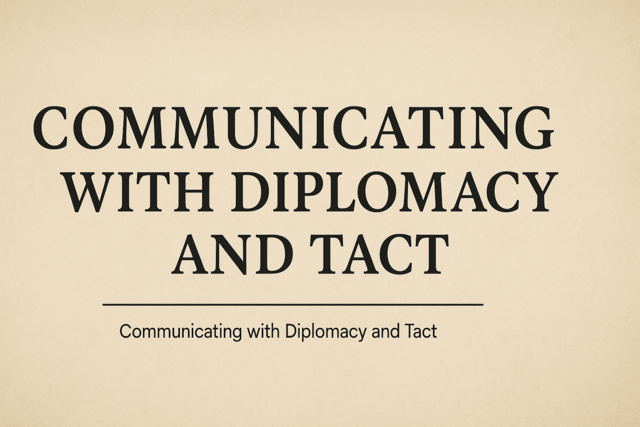Politeness Theory
The Merriam-Webster dictionary gives multiple definitions for the term polite. One definition is: "marked by an appearance of consideration, tact, deference, or courtesy." Although politeness is not a direct synonym for diplomacy and tact, they are certainly related. Therefore, as this is a study on communicating with diplomacy and tact, we will pay significant attention to the idea of politeness and cover various academic approaches to this concept.
We begin our exploration of politeness with a common theory known simply as "politeness theory." It was developed and put forth in the 1970s and 1980s by two researchers at Stanford University. They drew heavily from face theory, advancing face theory in the direction of, and with a focus on, politeness. In this endeavor, they dug deeper into the ideas of face put forth by Goffman in the 1950s and expanded on his theory, specifically with attention to politeness.
Politeness theory relies, in part, on the idea that there are different kinds of face: positive face and negative face. Positive face reflects an individual's need for his or her wishes and desires to be appreciated in a social context. This is the maintenance of a positive and consistent self-image. Negative face reflects an individual's need for freedom of action, freedom from imposition, and the right to make one's own decisions. Together, these types of face respect the face needs covered previously, which include an individual's face needs for autonomy and competence. This theory relies on the assumption that most speech acts inherently threaten either the speaker or the hearer's face, and that politeness is therefore a necessary component of unoffensive, i.e. non-face threatening, communication and involves the redressing of positive and negative face.
Drawing from these assumptions, researchers have identified three main strategies for performing speech acts: positive politeness, negative politeness, and off-record politeness. In positive politeness, the speaker's goal is to address the positive face needs of the hearer, thus enhancing the hearer's positive face. This is also known as positive face redress. Positive politeness strategies highlight friendliness and camaraderie between the speaker and hearer; the speaker's wants are in some way similar to the hearer's wants. There are many ways to accomplish this familiarity and claim common ground. First, the speaker can notice and attend to the hearer's wants, interests, needs, or goods. Second, the speaker can exaggerate his/her interest, approval or sympathy with the hearer. Third, the speaker can demonstrate an intensified interest to the hearer. The speaker can also use in-group markers, which demonstrate that both the speaker and hearer belong to the same social group, such as a work culture or religious affiliation. These can include forms of address, use of in-group language or dialect, use of jargon or slang, and linguistic contractions. An example might be, "Dude, you know�" or, "Brother, I'd like to discuss with you�" The speaker can also seek agreement with the hearer by choosing safe topics and using repetition. On the flip side of that, the speaker can also seek to avoid disagreement with the hearer by employing a token agreement, a pseudo-agreement, a white lie, or hedging an opinion. Further, the speaker can presuppose knowledge of the hearer's wants and attitudes, presuppose the hearer's values are the same as the speaker's values, presuppose familiarity in the speaker-hearer relationship, and presuppose the hearer's knowledge on the topic. Another strategy to invoke familiarity between speaker and hearer is to use humor/joking. In addition to claiming common ground, the speaker can use some tools to convey that the speaker and hearer are cooperators. These include asserting or presupposing the speaker's knowledge of, and concern for, the hearer's wants, offering or promising, being optimistic, including both speaker and hearer in a target activity, giving or asking for reasons, and assuming or asserting reciprocity. Finally, in an effort to establish positive politeness, the speaker can seek to fulfill the hearer's wants in some way. This can be induced through gift-giving, though these gifts can be material objects, as well as sympathy, understanding, or cooperation.
Examples of positive politeness include compliments, and might also include statements such as, "I really like the way you've done this," or, "It took me forever to figure this out, but what I eventually came to was�" or,"You know it's always important to me to do the best job I can, and I know the same is true for you. That's why I think we should pay attention to this piece a little," or, "I really like the way you approach this here. I think this other part might be a little stronger with a similar approach." In many of these cases, the speaker is bringing their own perspectives into the equation within his or her suggestions to the hearer; in this way, the speaker is emphasizing similarity and familiarity with the hearer and the content under discussion.
Where positive politeness enhances the hearer's positive and consistent self-image through recognizing the hearer's need for his or her wishes and desires to be appreciated socially, negative politeness addresses the hearer's need for freedom of action and freedom from imposition in making his or her own decisions. This is also known as negative face redress. The first approach to negative politeness is to be direct by being conventionally indirect. A second approach is to not assume or presume. These strategies include questions and hedges. (A hedge is a "softening" of a statement by employing less-than-certain phrasing such as perhaps, might, can, or could.) Third, negative politeness can be employed by not coercing the hearer. This can be accomplished by being pessimistic ("I'm sure you won't want to do this�"), minimizing the imposition ("It's a small thing I need�"), or giving deference ("you know much more about this than I do�"). The speaker can also communicate his/her desire to not impinge on the hearer. This can be accomplished through apologizing strategies that include admitting the impingement ("I know this is a big deal�"), indicating reluctance ("I hate to ask this�"), giving overwhelming reasons for having to ask, or begging forgiveness. Further efforts to not impinge on the hearer include impersonalizing the speaker and hearer. This strategies include using passive and circumstantial voices ("It's generally done this way�"), replacing "I" and "you" with indefinites ("people tend to�"), pluralizing "I" and "you" ("We don't always know what we're up against�"), and avoiding use of "I" and "you" all together. Therefore, negative politeness comments might include, "some people might approach the situation in this way," or "I think I might do it differently, but of course whatever you think is best," or "I don't know a lot about this but it seems that this approach might be reasonable and the situation" or "I know you know a lot more about this than I do, but it seems to me�" In these examples, the speaker is recognizing and addressing the hearer's right to make his or her own decisions freely, thus attending to the hearer's negative face needs.
Much research has been conducted on this topic, perhaps especially in the wake of Brown and Levinson's Politeness Theory. Though we all feel we have a sense for what politeness is, it's very difficult to pin it down when someone asks you to define it. One thing that researchers agree upon is that politeness is something that is learned or acquired. We are not born into it, but rather socialized into it. Further, because we are socialized into it, it naturally follows that different cultures have different ideas of what it is, and how it should be appropriately employed.
Defining Politeness
Some research counters Brown and Levinson's politeness theory by arguing that rather than dealing with politeness, per se, Brown and Levinson actually address the mitigation of face-threatening acts. That is, they don't talk about how to be polite, but rather how to not threaten someone's face. Whether or not this is the same thing is a matter of some debate.
Some research suggests that polite behavior goes beyond politic behavior, which is defined as "that behavior, linguistic and nonlinguistic, which the participants construct as being appropriate to the ongoing social interaction." This is behavior that is generally perceived to be appropriate, given the social constraints of a particular situation. Saying, "Yes, please," to the waitress when she offers you more coffee is an example of politic behavior � it doesn't stand out as being particularly polite or impolite, but rather merely socially appropriate. Polite behavior, then, is behavior beyond what is perceived as appropriate to the ongoing social interaction. Politeness goes beyond what is expected. To further our example from above, replying to the waitress's inquiry of whether we'd like more coffee, we might respond with, "Oh yes, please! Coffee would be wonderful. That's very kind of you." In this sense, then, polite behavior goes above and beyond what is merely called for.
Politeness versus Indirectness
The idea that politeness is essentially indirectness has captured the attention of several scholars conceptualizing and examining politeness. Some argue that indirectness does not necessarily imply politeness, as results from a study indicate that individuals don't always evaluate the most indirect approaches as the most polite. In this research, politeness is defined as a balance between two needs: the need for pragmatic clarity and the need to avoid coerciveness. Respondents considered that a certain adherence to the pragmatic clarity of a message is an essential component of politeness � that is, the practicing of social conventions yielding clarity in the message. However, too much pragmatic clarity, or too much coerciveness decreases politeness, rendering direct messages perceived as impolite, because they indicate a lack of concern with face. Further, non-conventional indirect strategies (hints) can be perceived as impolite in their lack of concern for pragmatic clarity � their vagueness and ambiguity tends to reduce their perception of politeness.
Impoliteness Defined
One way to consider what politeness is is to consider what it is not. This is an age-old method of defining something, put forth in the time of Socrates, who argued that a thing is both the thing itself and its opposite, since without its opposite, there is no thing to begin with. For example, there is no good without bad, first, since subjective assessments occur along a scale, and that something classified as bad helps then to define something classified as good. Second, if there were no bad there would be no good since there would be nothing to assess if everything always occurred at the same level of quality and at place along that scale. Thus, as the argument goes, both a thing and its opposite are intrinsic to that thing.
Applying this concept to our current topic, politeness, one way to classify and understand what politeness is is to offset it against what we know it is not. Thus, opposites of politeness can be impoliteness, rudeness, discourtesy, vulgarity, or crudeness. In considering our understandings of these terms, we can gain a better grasp for politeness.
A small amount of research has focused on impoliteness, which is defined as "behavior that is face-aggravating in a particular context." Some contend that impoliteness is rooted in the hearer's understanding of the speaker's intentions, and upon the sensitivity of the context.
That impoliteness is intertwined with power proves a provocative discussion. Researchers assert that there is, and can be, no interaction absent power, and that impoliteness is an exercise of power, as it tends to have (or perhaps always has) some effect on how one addresses others; it influences and alters the future action-environment of those with whom the speaker interacts. Impoliteness and power are inextricable because a speaker whose face is damaged by an utterance suddenly finds his or her response options sharply restricted. Additionally, those in positions of power have been found to exercise impoliteness more often than those in positions of relative low power.
Distinctions between "impoliteness" and "rudeness" are under debate by scholars, with disagreement whether or not they constitute the same ideas. Some argue that their evaluation as appropriate or not lies in the perspective of the one on the receiving end of the communication behavior. "Over-politeness", however, is classified among impoliteness and rudeness as generally negative and marked as inappropriate behavior. Behavior that is appropriate is generally unnoticed, rendering inappropriate behavior more likely noticeable or "marked".
"Over-politeness" exceeds the boundary between what is appropriate and what is inappropriate, rendering it less than polite, and is often considered downright rude. It is worth noting that this evaluation lies in the perception of the hearer. Over-politeness can fall into several categories. First, rather than impoliteness, over-politeness can be simply failed politeness attempts. However, over-politeness can certainly be used intentionally and/or perceived to be intentionally used to create a negative effect. Sarcasm fits into this category, which can also be considered "mock-politeness."
Politeness and Culture
Several researchers have pointed out that face concerns are culturally specific. Some work considers face as relational and interactional, rather than an individual, phenomenon. This means that the social self, or face, is achieved in relationships with others via interaction. Positive and negative face are re-conceptualized in terms of the contradictory tensions between connection with and separation from others.
Some research argues that Brown and Levinson's model doesn't adequately account for people of all nations and cultures, and that the dynamics of face in cultures such as China and Japan call for an alternative, more flexible framework. Here, researchers identify two competing forces shaping our interactional behaviors: ideal social identity and ideal individual autonomy. Face in China is highly complex, and relies on a persistent, mutually shared orientation toward constructing an ideal social identity.
Politeness and Swearing
When communicating politeness in conversations is there room for profanity? In other words, is swearing always impolite? Let us examine this question for a moment. The main purpose of swearing is to express emotions, primarily anger and frustration. Swear words are great ways to express these emotions as their primary meanings are connotative, rather than denotative. The emotional impact of swearing depends on a hearer's experience with a culture and its linguistic standards and practices. Research finds that the appropriateness of swearing as considered by hearers is evaluated by several criteria. First, whether swearing is appropriate depends highly upon the context in which it's used. Second, the speaker-listener relationship plays a major role in deeming swearing appropriate or not. Third, the social-physical context needs consideration (e.g. Are you in church? On a Navy ship?), and finally, the particular swear word used will render different effects on audience members. Offensiveness of swearing is perceived to depend upon characteristics of the one using swear words, as well. For native speakers, the gender of the speaker helps classify the appropriateness of swearing, while for non-native speakers, the level of English experience can be an evaluative factor. In sum, this study demonstrates that the appropriateness of swearing depends upon several factors, including characteristics of speaker, hearer, and context, and that these factors require time to fully understand.
In closing, the field of politeness research holds a few twists and turns, as most research areas do. Researchers disagree on definitions and applications of politeness and impoliteness. Nevertheless, we all know, as a practical matter, that politeness matters -- however we would like to define it. In a conversation about communicating with diplomacy and tact, a little digging into the theoretical ideas behind politeness can illuminate some of the complexity surrounding politeness classifications and usages. Perhaps it can be overly simplified as a matter of speaker, hearer, and context, all of which come into play in determining the appropriateness of a verbal or nonverbal communication behavior. We know that indirectness can be perceived as more polite than directness, and in this vein, perhaps asking questions, rather than making declarative statements, can mitigate a FTA. However, if this section reviewing politeness research demonstrates anything, it is that no one answer applies in all situations.






























